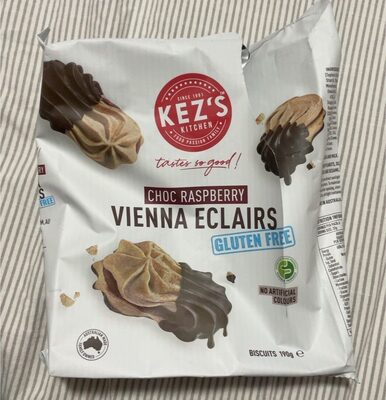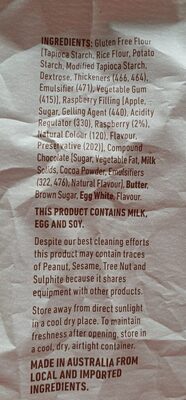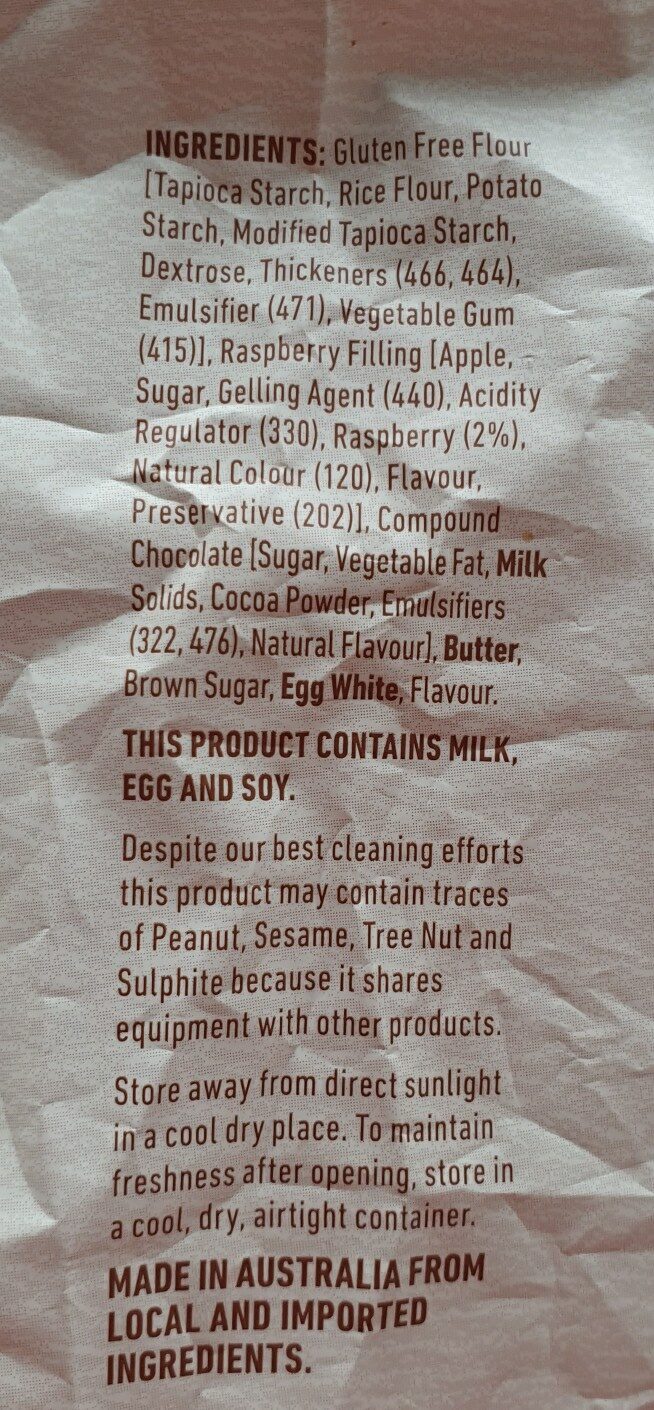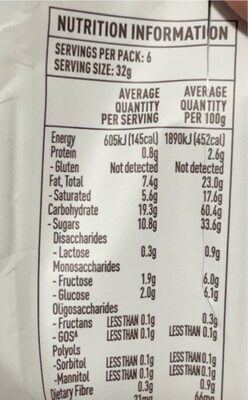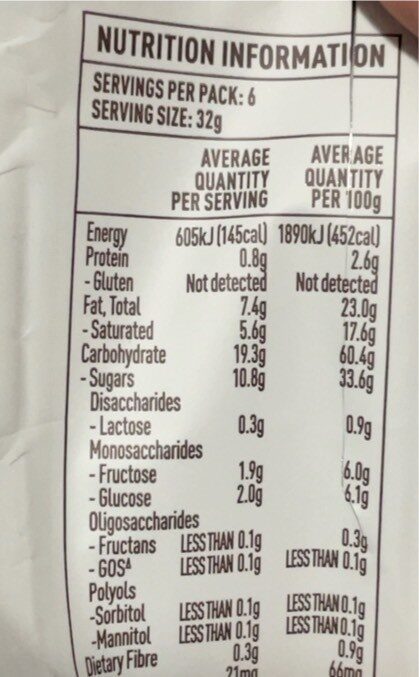Help us make food transparency the norm!
As a non-profit organization, we depend on your donations to continue informing consumers around the world about what they eat.
The food revolution starts with you!
Choc raspberry Vienna eclairs - Kez's
Choc raspberry Vienna eclairs - Kez's
This product page is not complete. You can help to complete it by editing it and adding more data from the photos we have, or by taking more photos using the app for Android or iPhone/iPad. Thank you!
×
Barcode: 9316450952440 (EAN / EAN-13)
Brands: Kez's
Categories: Snacks, Sweet snacks, Biscuits and cakes, Biscuits
Labels, certifications, awards: No gluten, Australian made
Stores: Woolworths, Coles
Countries where sold: Australia
Matching with your preferences
Health
Ingredients
-
42 ingredients
gluten free flour ttapioca starch, rice flour, potato starch, modified tapioca starch, dextrose, thickeners (466, 464), emulsifier (471), vegetable gum (415)], raspberry filling [apple, sugar, gelling agent (440), acidity regulator (330), raspberry (2%), natural colour (120), flavour, preservative (202)1, compound chocolate [sugar, vegetable fat, milk solids, cocoa powder, emulsifiers (322, 476), natural flavour), butter, brown sugar, egg white, flavour, this product contains milk, egg and soy, despite our best cleaning efforts this product may contain traces of peanut, sesame, tree nut and sulphite because it shares equipment with other products, store away from direct sunlight in a cool dry place, to maintain freshnessAllergens: Apple, Eggs, Milk, SoybeansTraces: Nuts, Peanuts, Sesame seeds
Food processing
-
Ultra processed foods
Elements that indicate the product is in the 4 - Ultra processed food and drink products group:
- Additive: E120 - Cochineal
- Additive: E322 - Lecithins
- Additive: E415 - Xanthan gum
- Additive: E440 - Pectins
- Additive: E464 - Hydroxypropyl methyl cellulose
- Additive: E466 - Sodium carboxy methyl cellulose
- Additive: E471 - Mono- and diglycerides of fatty acids
- Additive: E476 - Polyglycerol polyricinoleate
- Ingredient: Colour
- Ingredient: Dextrose
- Ingredient: Emulsifier
- Ingredient: Flavouring
- Ingredient: Gelling agent
- Ingredient: Glucose
- Ingredient: Thickener
Food products are classified into 4 groups according to their degree of processing:
- Unprocessed or minimally processed foods
- Processed culinary ingredients
- Processed foods
- Ultra processed foods
The determination of the group is based on the category of the product and on the ingredients it contains.
Additives
-
E120 - Cochineal
Carminic acid: Carminic acid -C22H20O13- is a red glucosidal hydroxyanthrapurin that occurs naturally in some scale insects, such as the cochineal, Armenian cochineal, and Polish cochineal. The insects produce the acid as a deterrent to predators. An aluminum salt of carminic acid is the coloring agent in carmine. Synonyms are C.I. 75470 and C.I. Natural Red 4. The chemical structure of carminic acid consists of a core anthraquinone structure linked to a glucose sugar unit. Carminic acid was first synthesized in the laboratory by organic chemists in 1991.Source: Wikipedia
-
E322 - Lecithins
Lecithins are natural compounds commonly used in the food industry as emulsifiers and stabilizers.
Extracted from sources like soybeans and eggs, lecithins consist of phospholipids that enhance the mixing of oil and water, ensuring smooth textures in various products like chocolates, dressings, and baked goods.
They do not present any known health risks.
-
E330 - Citric acid
Citric acid is a natural organic acid found in citrus fruits such as lemons, oranges, and limes.
It is widely used in the food industry as a flavor enhancer, acidulant, and preservative due to its tart and refreshing taste.
Citric acid is safe for consumption when used in moderation and is considered a generally recognized as safe (GRAS) food additive by regulatory agencies worldwide.
-
E415 - Xanthan gum
Xanthan gum (E415) is a natural polysaccharide derived from fermented sugars, often used in the food industry as a thickening and stabilizing agent.
This versatile food additive enhances texture and prevents ingredient separation in a wide range of products, including salad dressings, sauces, and gluten-free baked goods.
It is considered safe for consumption even at high intake amounts.
-
E440 - Pectins
Pectins (E440) are natural carbohydrates, predominantly found in fruits, that act as gelling agents in the food industry, creating the desirable jelly-like texture in jams, jellies, and marmalades.
Pectins stabilize and thicken various food products, such as desserts, confectioneries, and beverages, ensuring a uniform consistency and quality.
Recognized as safe by various health authorities, pectins have been widely used without notable adverse effects when consumed in typical dietary amounts.
-
E464 - Hydroxypropyl methyl cellulose
Hypromellose: Hypromellose -INN-, short for hydroxypropyl methylcellulose -HPMC-, is a semisynthetic, inert, viscoelastic polymer used as eye drops, as well as an excipient and controlled-delivery component in oral medicaments, found in a variety of commercial products.As a food additive, hypromellose is an emulsifier, thickening and suspending agent, and an alternative to animal gelatin. Its Codex Alimentarius code -E number- is E464.Source: Wikipedia
-
E466 - Sodium carboxy methyl cellulose
Carboxymethyl cellulose: Carboxymethyl cellulose -CMC- or cellulose gum or tylose powder is a cellulose derivative with carboxymethyl groups --CH2-COOH- bound to some of the hydroxyl groups of the glucopyranose monomers that make up the cellulose backbone. It is often used as its sodium salt, sodium carboxymethyl cellulose.Source: Wikipedia
-
E471 - Mono- and diglycerides of fatty acids
Mono- and diglycerides of fatty acids (E471), are food additives commonly used as emulsifiers in various processed foods.
These compounds consist of glycerol molecules linked to one or two fatty acid chains, which help stabilize and blend water and oil-based ingredients. E471 enhances the texture and shelf life of products like margarine, baked goods, and ice cream, ensuring a smooth and consistent texture.
It is generally considered safe for consumption within established regulatory limits.
-
E476 - Polyglycerol polyricinoleate
Polyglycerol polyricinoleate: Polyglycerol polyricinoleate -PGPR-, E476, is an emulsifier made from glycerol and fatty acids -usually from castor bean, but also from soybean oil-. In chocolate, compound chocolate and similar coatings, PGPR is mainly used with another substance like lecithin to reduce viscosity. It is used at low levels -below 0.5%-, and works by decreasing the friction between the solid particles -e.g. cacao, sugar, milk- in molten chocolate, reducing the yield stress so that it flows more easily, approaching the behaviour of a Newtonian fluid. It can also be used as an emulsifier in spreads and in salad dressings, or to improve the texture of baked goods. It is made up of a short chain of glycerol molecules connected by ether bonds, with ricinoleic acid side chains connected by ester bonds. PGPR is a yellowish, viscous liquid, and is strongly lipophilic: it is soluble in fats and oils and insoluble in water and ethanol.Source: Wikipedia
Ingredients analysis
-
May contain palm oil
Ingredients that may contain palm oil: Vegetable fat
-
Non-vegan
Non-vegan ingredients: Milk solids, Butter, Egg whiteSome ingredients could not be recognized.
We need your help!
You can help us recognize more ingredients and better analyze the list of ingredients for this product and others:
- Edit this product page to correct spelling mistakes in the ingredients list, and/or to remove ingredients in other languages and sentences that are not related to the ingredients.
- Add new entries, synonyms or translations to our multilingual lists of ingredients, ingredient processing methods, and labels.
If you would like to help, join the #ingredients channel on our Slack discussion space and/or learn about ingredients analysis on our wiki. Thank you!
-
Vegetarian status unknown
Unrecognized ingredients: Flour-ttapioca-starch, 466, 464, 471, Vegetable-gum, 415, 440, 330, 120, 202, 1, Compound-chocolate, 322, 476, Because-it-shares-equipment-with-other-products, Store-away-from-direct-sunlight-in-a-cool-dry-placeSome ingredients could not be recognized.
We need your help!
You can help us recognize more ingredients and better analyze the list of ingredients for this product and others:
- Edit this product page to correct spelling mistakes in the ingredients list, and/or to remove ingredients in other languages and sentences that are not related to the ingredients.
- Add new entries, synonyms or translations to our multilingual lists of ingredients, ingredient processing methods, and labels.
If you would like to help, join the #ingredients channel on our Slack discussion space and/or learn about ingredients analysis on our wiki. Thank you!
-
Details of the analysis of the ingredients
We need your help!
Some ingredients could not be recognized.
We need your help!
You can help us recognize more ingredients and better analyze the list of ingredients for this product and others:
- Edit this product page to correct spelling mistakes in the ingredients list, and/or to remove ingredients in other languages and sentences that are not related to the ingredients.
- Add new entries, synonyms or translations to our multilingual lists of ingredients, ingredient processing methods, and labels.
If you would like to help, join the #ingredients channel on our Slack discussion space and/or learn about ingredients analysis on our wiki. Thank you!
: flour ttapioca starch, rice flour, potato starch, modified tapioca starch, dextrose, thickeners (466, 464), emulsifier (471), vegetable gum (415), raspberry filling, apple, sugar, gelling agent (440), acidity regulator (330), raspberry 2%, natural colour (120), flavour, preservative (202), 1, compound chocolate, sugar, vegetable fat, milk solids, cocoa powder, emulsifiers (322, 476), natural flavour, butter, brown sugar, egg white, flavour, because it shares equipment with other products, store away from direct sunlight in a cool dry place, to maintain freshness- flour ttapioca starch -> en:flour-ttapioca-starch - labels: en:no-gluten - percent_min: 3.125 - percent_max: 74
- rice flour -> en:rice-flour - vegan: yes - vegetarian: yes - ciqual_food_code: 9520 - percent_min: 2 - percent_max: 38
- potato starch -> en:potato-starch - vegan: yes - vegetarian: yes - ciqual_proxy_food_code: 9510 - percent_min: 2 - percent_max: 26
- modified tapioca starch -> en:modified-tapioca-starch - vegan: yes - vegetarian: yes - ciqual_proxy_food_code: 9510 - percent_min: 2 - percent_max: 20
- dextrose -> en:dextrose - vegan: yes - vegetarian: yes - ciqual_proxy_food_code: 31016 - percent_min: 2 - percent_max: 16.4
- thickeners -> en:thickener - percent_min: 2 - percent_max: 14
- 466 -> en:466 - percent_min: 1 - percent_max: 14
- 464 -> en:464 - percent_min: 0 - percent_max: 7
- emulsifier -> en:emulsifier - percent_min: 2 - percent_max: 12.2857142857143
- 471 -> en:471 - percent_min: 2 - percent_max: 12.2857142857143
- vegetable gum -> en:vegetable-gum - percent_min: 2 - percent_max: 11
- 415 -> en:415 - percent_min: 2 - percent_max: 11
- raspberry filling -> en:raspberry-filling - vegan: maybe - vegetarian: maybe - ciqual_proxy_food_code: 31062 - percent_min: 2 - percent_max: 10
- apple -> en:apple - vegan: yes - vegetarian: yes - ciqual_food_code: 13050 - percent_min: 2 - percent_max: 9.2
- sugar -> en:sugar - vegan: yes - vegetarian: yes - ciqual_proxy_food_code: 31016 - percent_min: 2 - percent_max: 8.54545454545454
- gelling agent -> en:gelling-agent - percent_min: 2 - percent_max: 7.8875
- 440 -> en:440 - percent_min: 2 - percent_max: 7.8875
- acidity regulator -> en:acidity-regulator - percent_min: 2 - percent_max: 6.98863636363636
- 330 -> en:330 - percent_min: 2 - percent_max: 6.98863636363636
- raspberry -> en:raspberry - vegan: yes - vegetarian: yes - ciqual_food_code: 13015 - percent_min: 2 - percent: 2 - percent_max: 2
- natural colour -> en:natural-colours - percent_min: 0 - percent_max: 2
- 120 -> en:120 - percent_min: 0 - percent_max: 2
- flavour -> en:flavouring - vegan: maybe - vegetarian: maybe - percent_min: 0 - percent_max: 2
- preservative -> en:preservative - percent_min: 0 - percent_max: 2
- 202 -> en:202 - percent_min: 0 - percent_max: 2
- 1 -> en:1 - percent_min: 0 - percent_max: 2
- compound chocolate -> en:compound-chocolate - percent_min: 0 - percent_max: 2
- sugar -> en:sugar - vegan: yes - vegetarian: yes - ciqual_proxy_food_code: 31016 - percent_min: 0 - percent_max: 2
- vegetable fat -> en:vegetable-fat - vegan: yes - vegetarian: yes - from_palm_oil: maybe - percent_min: 0 - percent_max: 2
- milk solids -> en:milk-solids - vegan: no - vegetarian: yes - ciqual_proxy_food_code: 19051 - percent_min: 0 - percent_max: 2
- cocoa powder -> en:cocoa-powder - vegan: yes - vegetarian: yes - ciqual_food_code: 18100 - percent_min: 0 - percent_max: 2
- emulsifiers -> en:emulsifier - percent_min: 0 - percent_max: 2
- 322 -> en:322 - percent_min: 0 - percent_max: 2
- 476 -> en:476 - percent_min: 0 - percent_max: 1
- natural flavour -> en:natural-flavouring - vegan: maybe - vegetarian: maybe - percent_min: 0 - percent_max: 2
- butter -> en:butter - vegan: no - vegetarian: yes - ciqual_proxy_food_code: 16400 - percent_min: 0 - percent_max: 2
- brown sugar -> en:brown-sugar - vegan: yes - vegetarian: yes - ciqual_food_code: 31017 - percent_min: 0 - percent_max: 2
- egg white -> en:egg-white - vegan: no - vegetarian: yes - ciqual_food_code: 22001 - percent_min: 0 - percent_max: 2
- flavour -> en:flavouring - vegan: maybe - vegetarian: maybe - percent_min: 0 - percent_max: 2
- because it shares equipment with other products -> en:because-it-shares-equipment-with-other-products - percent_min: 0 - percent_max: 2
- store away from direct sunlight in a cool dry place -> en:store-away-from-direct-sunlight-in-a-cool-dry-place - percent_min: 0 - percent_max: 2
- to maintain freshness -> en:preservative - percent_min: 0 - percent_max: 2
Nutrition
-
Poor nutritional quality
⚠ ️Warning: the amount of fruits, vegetables and nuts is not specified on the label, it was estimated from the list of ingredients: 2This product is not considered a beverage for the calculation of the Nutri-Score.
Positive points: 5
- Proteins: 1 / 5 (value: 2.5, rounded value: 2.5)
- Fiber: 5 / 5 (value: 65.625, rounded value: 65.63)
- Fruits, vegetables, nuts, and colza/walnut/olive oils: 0 / 5 (value: 2.288671875, rounded value: 2.3)
Negative points: 22
- Energy: 5 / 10 (value: 1896, rounded value: 1896)
- Sugars: 7 / 10 (value: 33.75, rounded value: 33.75)
- Saturated fat: 10 / 10 (value: 17.5, rounded value: 17.5)
- Sodium: 0 / 10 (value: 65.625, rounded value: 65.6)
The points for proteins are not counted because the negative points are greater or equal to 11.
Nutritional score: (22 - 5)
Nutri-Score:
-
Nutrient levels
-
Fat in high quantity (23.1%)
What you need to know- A high consumption of fat, especially saturated fats, can raise cholesterol, which increases the risk of heart diseases.
Recommendation: Limit the consumption of fat and saturated fat- Choose products with lower fat and saturated fat content.
-
Saturated fat in high quantity (17.5%)
What you need to know- A high consumption of fat, especially saturated fats, can raise cholesterol, which increases the risk of heart diseases.
Recommendation: Limit the consumption of fat and saturated fat- Choose products with lower fat and saturated fat content.
-
Sugars in high quantity (33.8%)
What you need to know- A high consumption of sugar can cause weight gain and tooth decay. It also augments the risk of type 2 diabetes and cardio-vascular diseases.
Recommendation: Limit the consumption of sugar and sugary drinks- Sugary drinks (such as sodas, fruit beverages, and fruit juices and nectars) should be limited as much as possible (no more than 1 glass a day).
- Choose products with lower sugar content and reduce the consumption of products with added sugars.
-
Salt in low quantity (0.164%)
What you need to know- A high consumption of salt (or sodium) can cause raised blood pressure, which can increase the risk of heart disease and stroke.
- Many people who have high blood pressure do not know it, as there are often no symptoms.
- Most people consume too much salt (on average 9 to 12 grams per day), around twice the recommended maximum level of intake.
Recommendation: Limit the consumption of salt and salted food- Reduce the quantity of salt used when cooking, and don't salt again at the table.
- Limit the consumption of salty snacks and choose products with lower salt content.
-
-
Nutrition facts
Nutrition facts As sold
for 100 g / 100 mlCompared to: Biscuits Energy 1,896 kj
(453 kcal)-0% Fat 23.125 g +19% Saturated fat 17.5 g +76% Carbohydrates 60.312 g -0% Sugars 33.75 g +20% Fiber 65.625 g +1,901% Proteins 2.5 g -59% Salt 0.164 g -72% Fruits‚ vegetables‚ nuts and rapeseed‚ walnut and olive oils (estimate from ingredients list analysis) 2.289 %
Environment
-
Eco-Score C - Moderate environmental impact
⚠ ️The full impact of transportation to your country is currently unknown.The Eco-Score is an experimental score that summarizes the environmental impacts of food products.→ The Eco-Score was initially developped for France and it is being extended to other European countries. The Eco-Score formula is subject to change as it is regularly improved to make it more precise and better suited to each country.Life cycle analysis
-
Average impact of products of the same category: B (Score: 69/100)
Category: Biscuit (cookie)
Category: Biscuit (cookie)
- PEF environmental score: 0.35 (the lower the score, the lower the impact)
- including impact on climate change: 2.88 kg CO2 eq/kg of product
Stage Impact Agriculture
80.5 %Processing
11.8 %Packaging
3.1 %Transportation
3.2 %Distribution
1.4 %Consumption
0.0 %
Bonuses and maluses
-
Missing origins of ingredients information
Malus:
⚠ ️ The origins of the ingredients of this product are not indicated.
If they are indicated on the packaging, you can modify the product sheet and add them.
If you are the manufacturer of this product, you can send us the information with our free platform for producers.
-
Missing packaging information for this product
Malus: -15
⚠ ️ The information about the packaging of this product is not filled in.⚠ ️ For a more precise calculation of the Eco-Score, you can modify the product page and add them.
If you are the manufacturer of this product, you can send us the information with our free platform for producers.
Eco-Score for this product
-
Impact for this product: C (Score: 49/100)
Product: Choc raspberry Vienna eclairs - Kez's
Life cycle analysis score: 69
Sum of bonuses and maluses: -15
Final score: 49/100
-
Carbon footprint
-
Equal to driving 1.5 km in a petrol car
288 g CO² per 100g of product
The carbon emission figure comes from ADEME's Agribalyse database, for the category: Biscuit (cookie) (Source: ADEME Agribalyse Database)
Stage Impact Agriculture
82.9 %Processing
7.9 %Packaging
3.8 %Transportation
4.7 %Distribution
0.7 %Consumption
0.0 %
Packaging
-
Missing packaging information for this product
⚠ ️ The information about the packaging of this product is not filled in.Take a photo of the recycling information Take a photo of the recycling information
Transportation
-
Origins of ingredients
Missing origins of ingredients information
⚠ ️ The origins of the ingredients of this product are not indicated.
If they are indicated on the packaging, you can modify the product sheet and add them.
If you are the manufacturer of this product, you can send us the information with our free platform for producers.Add the origins of ingredients for this product Add the origins of ingredients for this product
Report a problem
-
Incomplete or incorrect information?
Category, labels, ingredients, allergens, nutritional information, photos etc.
If the information does not match the information on the packaging, please complete or correct it. Open Food Facts is a collaborative database, and every contribution is useful for all.
Data sources
Product added on by openfoodfacts-contributors
Last edit of product page on by archanox.
Product page also edited by clockwerx, inf, kiliweb, yuka.sY2b0xO6T85zoF3NwEKvll4YdIT3-B_DbyflkHCMzPqPCJ3Wbt9v-7njIqs.
